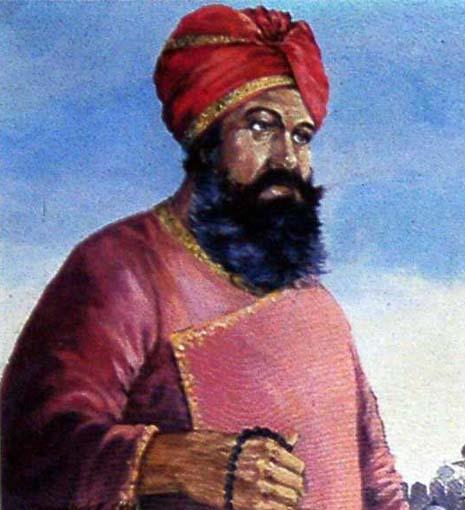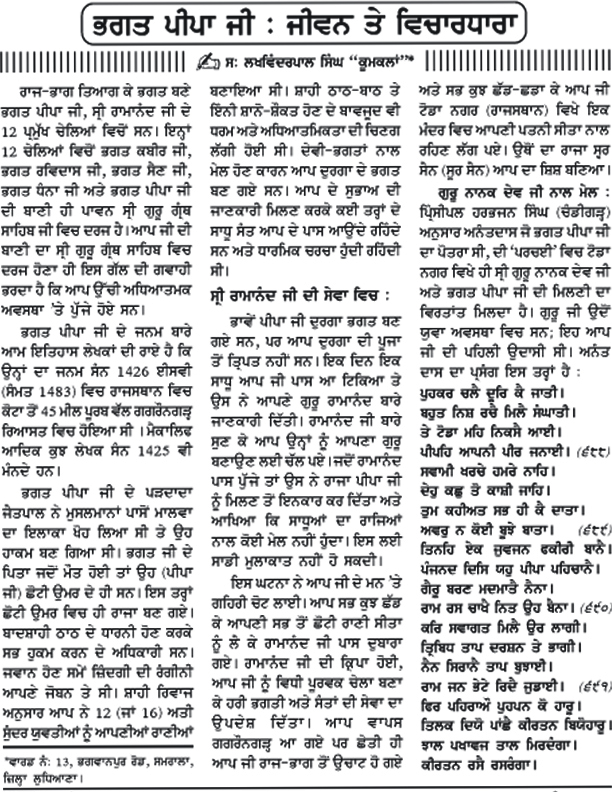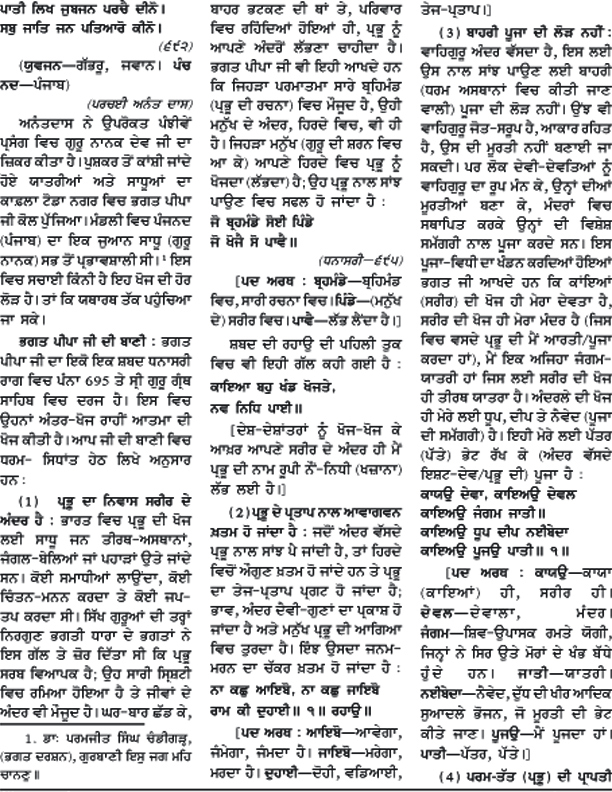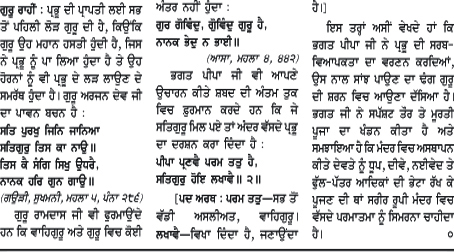Bhagat Pipa
| Devotee Peepa | |
| Full Name : | King Pipaji |
| Spouse : | Rani Sita |
| Birth : | 5th April 1425, Gagron, Jhalawar, Rajasthan, India |
| Children : | Raja Dwarkanath |
| Profession : | Ruler of Gagron |
| Death : | Submerge their soul with the GOD |
| Other Info: | 1 Shabad in Guru Granth Sahib |
Bhagat Pipa, (Gurmukhi: ਭਗਤ ਪੀਪਾ)(5th April 1425) also known as Raja Pipaji or Rao Pipa or Sardar Pipa or Sant Pipaji or Pipa Bairagi or Pipanand Acharya, was a mystic poet, Rajput ruler turned saint. He was a devotee of God, a king, a Gurmukh, and a supporter of Gurmat.
His bani is incorporated in the Sri Guru Granth Sahib Ji. He was a prince who renounced his throne in the search of spiritual solace and said that one should search within for God. He said that one's inner self has a relation with God. He disdained the idea of finding God in the outer world in any form. He was a Deity worshipper once, probably of Goddess Bhavani, but when he found God in himself, he discarded all these other notions of society, i.e idol worshipping.
Bhagat Peepa Ji, Bhagat Kabir Ji, Guru Nanak Dev Ji, Bhagat Ravidas Ji, and Bhatts are all the same and all are treated as Gurus and Sikhs bow before the Sri Guru Granth Sahib Ji which includes the teachings of many who had similar thoughts as Bhagat Pipa Ji had about God.
Early Life
Raja Pipaji was born, as Pratap Rao, at Gagaron, in present-day Jhalawar district of Rajasthan in a Khichi Chauhan Rajput family. His great grandfather King Jaitpal obtained possession of Gagron by killing Kamal-Ud-Din, Governor.[3] Raja Pipaji was successor of Rao Khandwa and ruled Gagron possibly between 1360 to 1385.[3]
He had 12 queens among those Rani Sita was his devout lady and was very dear to him. Sita was daughter of King Haja Solanki of Toda Rai Singh in District Tonk. Her name was Padmavati which was changed to sita after marriage.
Life
He was born at Gagron, in present-day Jhalawar district of Rajasthan, 5th April 1425.
His great grand father named Jaitpal won the Malwa area from muslims and became its king. As Pipa's father died young, so Pipa became king. Because of youthfulness and customs he had 12 to 16 queens. Though he was very rich and had a great personality, he was also a spiritual and Godly person. He was a devotee of the Goddess Bhavani whose idol was enshrined in a temple within the premises of his palace. It is said that the Goddess once told him in a dream to visit Kashi (Varanasi) and receive initiation from Bhagat Ramanand
He was a king of Gagron garh, situated at about 50 miles to the east of Kotanagar in the present-day Jhalawar district of Rajasthan State. He was born in a Chauhan rajput family in AD 5th April 1425 (1483 Samvat). According to the British historian of Sikhism, J.D. Cunningham, he was the ninth descendant of Raja Jaitpal. However, Giani Gian Singh, Twarikh Guru Khalsa (Part-1, p. 143) gives 1462 Bikrami as the year of his birth. It is also stated in this work that Pipa was born at Jhala, and spent his entire life at Patan in meditation of God: this Patan town is situated near Jodhpur in Rajasthan. Since Pipa came of a royal family, he enjoyed all the pleasures and comforts of a royal life and his life were full of all sorts of physical enjoyments. In the true royal custom, he married a dozen beautiful maidens who lived with him in his palace as his queens. Inspite of all this, a spark of Divine love was still alive in his heart. He was a devotee of goddess, Durga, the deity in which he perceived the divine reflection. He also took time from courtly cares and pleasures of flesh to spend it in the company of the holy persons. These later persuaded him that the special efforts need to be made to realize God. So he resolved to go to Ramanand to seek spiritual guidance.
Bhagat Pipa & Bhagat Ramanand
Folks say, Pipa went to Kashi, but Ramanand refused to see him in his gaudy robes. Pipa cast off his royal apparel and put on a mendicant’s garment. He returned home after initiation and began to live like an ascetic. At his invitation Ramanand visited Gagron, and the raja lent his shoulder to the palanquin carrying him in a procession.
Pipa-Nanak meet?
Some people claim that Pipa met Nanak during journeys but this point is not proven. It is also said that Bhagat Pipa once met Guru Nanak in Toda town. This discovery generates through the Parchai of Anant Dass (who was the grandson of Bhagat Pipa), found by Principal Harbhajan Singh of Chandigarh. In this Parchai Anantdass wrote that the tola of sadhus was going from Pushkar to Kashi and stayed at Toda town. In this tola a Sadhu from the Punjab was looking Godly and great person and according to them that person was Guru Nanak but the fact has not been proven.
It is believed that Pipa lived before Nanak's time and was here on earth at same time as Kabir, Ramanand, Sain etc were.
Bhagat Pipa in Dwarka
Pipa finally decided to give up his throne and retire to a life of seclusion and meditation. He went to Dwarka (Gujarat) where Lord Krishna, after the Mahabharata war, had spent the last years of his life. All the twelve wives of Pipa insisted on accompanying him, but he took along only one, named Sita, who was of a pious temperament. He selected a cave for his residence from where he walked daily through a tunnel to the temple of Krishna on the sea coast. The temple is still a popular place of pilgrimage and a fair is held there annually in Pipa’s memory. After what he thought was a personal encounter with the Lord, he gave up idol-worship.
He and his companion-wife started living in a jungle. After a period of penance, he set out roaming about the country to serve the common people. He, along with his wife, sang hymns and prayers of his own composition and collected money to be distributed among the poor. He fed the mendicants and treated them as God’s chosen ones.
Once an idol-worshipper (saguna bhakta) Pipa became a worshipper of the Formless One (nirguna devotee).
As he says in his hymn in the Guru Granth Sahib, the body itself is the Supreme Being’s temple (kaiau deval). One need not make stone images of Him and burn incense or light candles in front of them. Pipa composed many hymns in praise of the Lord and sang them along with his wife for seeking alms. The money he received was put to the service of the poor.
Two collections of Pipa’s sayings are known to exist, namely Shn Pipa ji Bani and Sarab Gutaka, both in manuscript form. Pipa Math, a monastery in Dwarka, honours his memory.
Life Study through his Bani
A Gurmukh can easily understand life of Bhagat Pipa's through his Bani, in which he himself tells his beliefs before encountering with Gurmat. Following facts are clear from his Bani:
- Renouncer turned householder: This belief is confirmed from above story and from his Bani too. Before finding Gurmat, he was an ascetic, as written ਕਾਇਆ ਬਹ ਖੰਡ ਖੋਜਤੇ ਨਵ ਨਿਧਿ ਪਾਈ ॥ , but after experiencing Gurmat he changed. He said ਜੋ ਬਰਹਮੰਡੇ ਸੋਈ ਪਿੰਡੇ ਜੋ ਖੋਜੈ ਸੋ ਪਾਵੈ ॥, which means what one finds in the world is actually present in one's inner body. It means after having encounter with Gurmat he came back to his home or preached Gurmat only thereafter.
- Do not support pilgrimages: Peepa find that there is no use of going for pilgrimages as God is present in one's heart all the time and one should visit there and purify it with God's name, ਕਾਇਅਉ ਜੰਗਮ ਜਾਤੀ ॥
- was against Ritualism: While worshipping, people use light essence etc. which Peepa says is of no use. It's better if one does aarti of one's own inner body with Gurmat.
Shabad by Bhagat Pipa
ਪੀਪਾ ॥
पीपा ॥
Peepaa:
ਕਾਯਉ ਦੇਵਾ ਕਾਇਅਉ ਦੇਵਲ ਕਾਇਅਉ ਜੰਗਮ ਜਾਤੀ ॥
कायउ देवा काइअउ देवल काइअउ जंगम जाती ॥
Within the body, the Divine Lord is embodied. The body is the temple, the place of pilgrimage, and the pilgrim.
ਕਾਇਅਉ ਧੂਪ ਦੀਪ ਨਈਬੇਦਾ ਕਾਇਅਉ ਪੂਜਉ ਪਾਤੀ ॥੧॥
काइअउ धूप दीप नईबेदा काइअउ पूजउ पाती ॥१॥
Within the body are incense, lamps and offerings. Within the body are the flower offerings. ||1||
ਕਾਇਆ ਬਹ ਖੰਡ ਖੋਜਤੇ ਨਵ ਨਿਧਿ ਪਾਈ ॥
काइआ बहढ़ खंड खोजते नव निधि पाई ॥
I searched throughout many realms, but I found the nine treasures within the body.
ਨਾ ਕਛ ਆਇਬੋ ਨਾ ਕਛ ਜਾਇਬੋ ਰਾਮ ਕੀ ਦਹਾਈ ॥੧॥ ਰਹਾਉ ॥
ना कछढ़ आइबो ना कछढ़ जाइबो राम की दढ़हाई ॥१॥ रहाउ ॥
Nothing comes, and nothing goes; I pray to the Lord for Mercy. ||1||Pause||
ਜੋ ਬਰਹਮੰਡੇ ਸੋਈ ਪਿੰਡੇ ਜੋ ਖੋਜੈ ਸੋ ਪਾਵੈ ॥
जो बढ़रहमंडे सोई पिंडे जो खोजै सो पावै ॥
The One who pervades the Universe also dwells in the body; whoever seeks Him, finds Him there.
ਪੀਪਾ ਪਰਣਵੈ ਪਰਮ ਤਤ ਹੈ ਸਤਿਗਰ ਹੋਇ ਲਖਾਵੈ ॥੨॥੩॥
पीपा पढ़रणवै परम ततढ़ है सतिगढ़रढ़ होइ लखावै ॥२॥३॥
Shabad by Bhagat Pipa
Within the body, the Divine Lord is embodied.
The body is the temple, the place of pilgrimage, and the pilgrim.
Within the body are incense, lamps and offerings.
Within the body are the flower offerings. || 1 ||
I searched throughout many realms, but I found the nine treasures within the body. Nothing comes, and nothing goes;
I pray to the Lord for Mercy. || 1 || Pause ||
The One who pervades the Universe also dwells in the body; whoever seeks Him, finds Him there.
Pipa prays, the Lord is the supreme essence;
He reveals Himself through the True Guru.
Peepaa prays, the Lord is the supreme essence;
He reveals Himself through the True Guru. ||2||3||
Bhagat Pipa (Gurmat Wichardhara)
Bhagat Pipa's Bani
Bhagat Pipa's bani can be found in the following ANG (page) of Guru Granth Sahib:
- Bhagat Pipa, pg. 695
You can also join us on Facebook page for more info
https://www.facebook.com/pages/Bhagat-Pipaji-Maharaj-Pipavanshi-Darji/1440291719554123
References
- Sikh Phulwari
- Extracted from Gurbani De Racheta by Abnashi & Gurvinder Singh
- Excerpts taken from Encyclopedia of Sikhism by Harbans Singh. Published by Punjabi University, Patiala
| These are the 15 Bhagats of Sikhism |
|
Bhagat Beni | Bhagat Bhikhan | Bhagat Dhanna | Sheikh Farid | Bhagat Jaidev | Bhagat Kabir | Bhagat Namdev | Bhagat Parmanand | Bhagat Pipa | Bhagat Ramanand | Bhagat Ravidas | Bhagat Sadhna | Bhagat Sain | Bhagat Surdas | Bhagat Trilochan |




